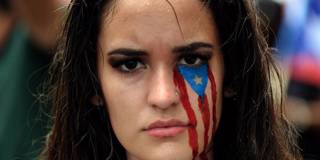After mounting protests, Ricardo Rosselló has resigned as governor of Puerto Rico, putting the territory's most immediate political crisis to rest. But what the US territory really needs is an accord with officials on the mainland to start addressing structural issues that have been impeding economic growth and formal employment.
WASHINGTON, DC – Puerto Rico is once again in crisis, both politically and economically. A United States territory with more than three million people, it has a larger population than many US states. But its population and real (inflation-adjusted) output have been falling since 2006. More than half of native-born Puerto Ricans alive today have left the island, most of them for the US mainland. The territory’s per capita income is around half that of the poorest US state, Mississippi.
While the Puerto Rican economy reached dire straits in 2016, its problems go back much further. For the past decade, successive governments promising balanced budgets have consistently been forced to borrow after their estimates proved overly optimistic. Eventually, Puerto Rico was unable to meet its debt-servicing obligations. By 2015, its per capita debt was more than $16,000, compared to the 50 states’ average of $1,473, and its government still had large unfunded obligations.
Then, in June 2016, the US Congress passed PROMESA (the Puerto Rico Oversight, Management, and Economic Stability Act), which allowed Puerto Rico to enter quasi-bankruptcy proceedings under the supervision of a newly created Financial Oversight and Management Board. The FOMB would approve the territory’s budgets. In 2017, the island defaulted on its debt, and there have been legal battles ever since.

WASHINGTON, DC – Puerto Rico is once again in crisis, both politically and economically. A United States territory with more than three million people, it has a larger population than many US states. But its population and real (inflation-adjusted) output have been falling since 2006. More than half of native-born Puerto Ricans alive today have left the island, most of them for the US mainland. The territory’s per capita income is around half that of the poorest US state, Mississippi.
While the Puerto Rican economy reached dire straits in 2016, its problems go back much further. For the past decade, successive governments promising balanced budgets have consistently been forced to borrow after their estimates proved overly optimistic. Eventually, Puerto Rico was unable to meet its debt-servicing obligations. By 2015, its per capita debt was more than $16,000, compared to the 50 states’ average of $1,473, and its government still had large unfunded obligations.
Then, in June 2016, the US Congress passed PROMESA (the Puerto Rico Oversight, Management, and Economic Stability Act), which allowed Puerto Rico to enter quasi-bankruptcy proceedings under the supervision of a newly created Financial Oversight and Management Board. The FOMB would approve the territory’s budgets. In 2017, the island defaulted on its debt, and there have been legal battles ever since.